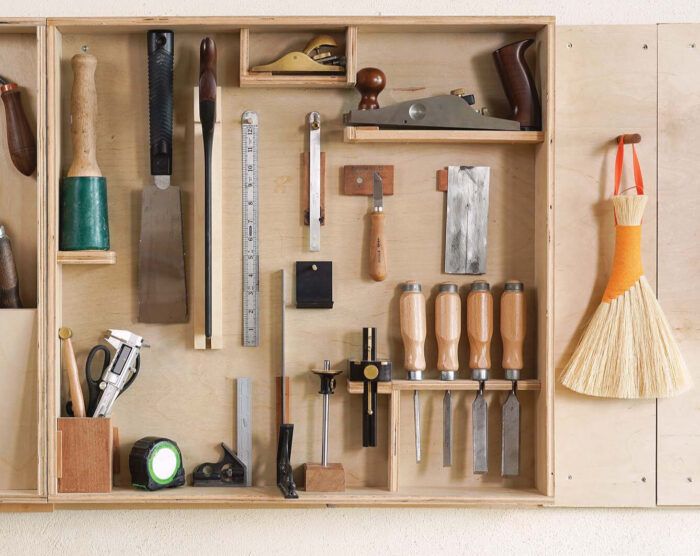Florida School of Woodwork puts these tools at every workbench.

Students of all skill levels and experience attend the school I founded in 1997. Because many fly into Tampa to attend classes, it’s difficult for some to bring tools. Others are new to the craft and don’t know yet what to purchase. So we created an essential hand-tool kit that hangs in a wall cabinet beside each workbench.
Simple in construction, the cabinet would make a great weekend project. It’s made of 1/2-in. plywood and assembled with glue and brad nails, and it has custom hangers and holders for each tool. I must tip my hat here to Lou Fuller, a visiting teacher who helped us build the boxes.
Our budget was tight in the early days, so we chose the tools we thought would be most useful. We benefited from observing which tools our instructors reached for most frequently, and we have refined the contents of the cabinet over time. I think our current kits are spot-on.
I’d like to share our essential hand-tool kit both as a guide for new woodworkers and as a wish list for experienced ones. I’ll present the tools in order of usefulness, to make the point that they don’t need to be purchased all at once. Some also require more skill to use, making them better candidates for later acquisition.

I’ll also tell you the specific sizes, brands, and models we chose. While there are plenty of other good options out there, I think you’ll find that these models offer good value. All do their jobs well, and all are robust enough to serve you for a lifetime.
Next to the main tool cabinet at each bench you’ll see a smaller cabinet, which we added later to house a handful of chairmaking tools, including two travishers, a reamer, and a drawknife. These are used during our popular Windsor-chair classes, but they aren’t essential for general furniture making.
Hand tools to buy first
Our earliest purchases were the most important. These are the tools that get used in almost every class. I encourage you to buy them as a group, which will cost $350 to $400 if you buy new.
Tape measure—Look for something compact, and dedicate it to your workshop. Treat it kindly and don’t let anyone borrow it. If you have more than one, label the one you trust most for accuracy.
Combo square—A 6-in. combination square is great for laying out joinery and setting up tools properly. So get something you can trust to be square. We also wanted a nice fit and finish, and a blade that stays locked in place. You won’t find a square like this at most home centers. Recently we added 12-in. squares to our kits. These don’t get used as much, but they are essential when you need to carry lines across longer surfaces. You might also want to consider a 4-in. square, which fits in an apron pocket.
Marking knife—We used several marking knives over the years before settling on a Pfiel model that is easily handled and holds its edge. Our older models had longer blades, but we found that students tended to flex those by applying too much pressure. The Pfiel knives are sturdy and can be resharpened many times.
Marking gauge—A marking gauge specializes at scribing layout lines parallel to a reference edge. I used to be snooty about these tools, valuing the traditional knife-style over wheel blades. The truth is that a wheel-type marking gauge is easier to use. Also, humble pie is delicious.
Bench chisels—Chisels are essential for forming joints and paring them to fit. While I can’t say I absolutely love the chisels we use, they comprise a good starter set at a reasonable price, and the blades have survived a lot of torture by new students.
What you’re looking for here are chisels that match common joint sizes, feel comfortable in the hand, and hold their edges. Our set includes 1/4-, 1/2-, 3/4-, and 1-in. sizes. We also have a longer 3/8-in. chisel in our chairmaking kit. You’ll also need a way to keep your chisels sharp. We recommend the book Sharpen This by Chris Schwarz ($20, Lost Art Press), and Fine Woodworking also has lots of great articles on the subject.
Mallet—Like golf clubs, there are mallets for every imaginable purpose. But we use just one, with a urethane head. It’s designed to power chisels for joinery and gouges for carving, and it’s perfect for those tasks.
Handsaws—Handsaws excel at a variety of tasks, from crosscuts to ripcuts, and from intricate joinery to general cutting. There are two main types: Western saws, which cut on the push stroke; and Japanese-style saws, which cut on the pull stroke. While you really need only one type in your tool kit, we include both in ours. That’s partly because some woodworkers prefer one type over the other, but it’s also because we like to let people try both. Both are medium-size saws that are good for a range of tasks, including dovetailing. Our Western-style saw has a stiff back, making it a little better for precise joinery cuts. Our Japanese saw is a ryoba, which has two cutting edges, one for ripping and one for crosscutting, and is maybe a bit better for general cutting tasks. Quality Japanese saws, considerably less expensive than top-notch Western models, are a good type to try first.
 |
 |
After your skills evolve
Once you settle into the craft, you’ll need more hand tools, and your skills will be ready for them. The following list is buy-as-you-need, or buy-as-your-budget-allows. Together these tools enable students to do almost all of their benchwork.
Digital calipers—A good pair of dial or digital calipers will add accuracy to your woodworking. These tools set up machines precisely, tell you exactly how much needs to come off a tenon for a good fit, let you creep up on the perfect thickness when milling, and assist with many other common woodworking tasks.
Block plane—A block plane is the handiest type of hand plane and the first one most woodworkers buy. Its compact size makes it easy to handle, and it’s ideal for fine-tuning and shaping smaller surfaces. The Lie-Nielsen No. 102 Low Angle Block Plane is impossible to beat. It’s a joy to use, and a bargain at $160.
Bench plane—It’s easy to fall headlong into the world of plane collecting, but a single bench plane will handle most of the larger surfaces a woodworker tackles. We tried wood-bodied hand planes in the past, choosing them for their tradition and charm rather than pure performance. We recently switched to a metal-bodied model, which is much easier to adjust and use. The Veritas smooth plane can do everything from rough prep to refined smoothing. If your budget only has room for one full-size bench plane, this one sits right in the Goldilocks zone—not too big and not too small.
Spokeshave—A spokeshave is the best tool for shaping shallow curves, making them “fair” and smooth in the process. I love seeing the pleasure new students take in using this tool, which is a revelation for many.
Card scraper—This inexpensive tool can level and smooth surfaces that a hand plane might tear out. You’ll also need a burnisher—a tool used to form the tiny hook a scraper cuts with—plus a little practice at using it. But after that, you’ll be able to scrape inlay flush, remove tearout and planing marks, and save stacks of sandpaper in the process.
Coping saw—You’ll use a coping saw for making tight curve cuts, cutting out the waste between dovetails, and doing other tasks where you need a skinny blade that can turn a sharp corner. Once you dive into hand-cut joinery, add this tool to your kit. Our coping saw isn’t the fanciest, but it’s a great deal and very serviceable. If you’re looking for an upgrade, try one of the stiffer, lighter coping saws from Knew Concepts.
Router plane—A router plane helps you to level and deepen the bottom of dadoes, mortises, inlay pockets, and any other recesses where consistent depth is essential.
Three nice additions
Depending on how you work, you might consider the following tools to be just as essential as the others. We don’t have one of each for every student, but there are plenty lying around the shop.
A sliding bevel gauge helps with a wide variety of tasks. Students use it to lay out cuts and transfer angles in a wide variety of ways. That could be transferring an angle from a drawing to a workpiece, from one furniture part to another, or from a drawing or workpiece to a machine setup, like the angle of a miter-gauge fence or miter-saw blade.
A saddle square lets you wrap measurements and layout lines around a corner, from one adjoining surface to another. We use ours most often to knife a square line for handsaw work. But it’s great for pencil lines also.
A dovetail saddle marker is similar to the saddle square, but its marking edge is set at your preferred dovetail angle. You can use a bevel gauge to mark dovetails, but it’s nice to have a tool permanently set at just the right angle.
The hand tools we provide each student are by no means the only ones they will ever need. But they get used almost every day at our school and represent a great starter kit for woodworkers of all levels and interests.
—Kate Swann is the director of the Florida School of Woodwork, in Tampa.
First purchases
The firsthand tools the school bought are the first ones most woodworkers need. We’ve specified the models the school has settled on over the years.
Large measurements. You’ll need an accurate tape at the lumberyard and in the shop for marking rough cuts, plywood cuts, and much more. Look for at least 12 ft. of length, with easy-to-read markings.
Fastcap ProCarpenter 16 ft. PSSR
Pro Carpenter Standard Reverse Measuring Tape
The Standard/Standard Reverse features standard measurements that are readable when the tape is extended from either the right or left hand.
Price: $14 at the time of writing
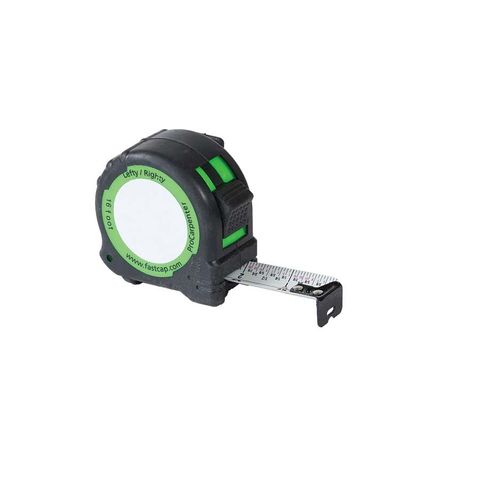
Workshop workhorse. A combination square can be used to set up tools and machines, layout joinery, and lots more.
Fine lines for joinery. A marking knife strikes a more accurate line than a pencil, and it incises the line into the surface, leaving you a place to start your chisel.
Pfiel Swiss Made No. 4 Chip-Carving Knife
Pfeil carving tools and Pfeil carving tool sets are “Swiss Made.” Forged of special alloy tool steel, blades hold their edge longer than most other knives of this type. Pre-sharpened for immediate use. Overall lengths between 5-1/4″ to 7-1/2″. Rc 57-60 hardness.
Price: $31.48 at the time of writing
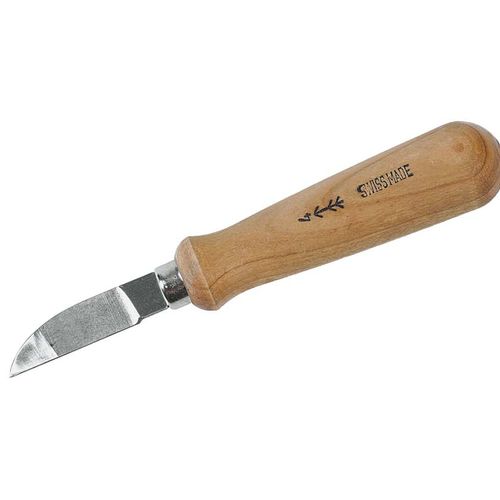
Fine lines parallel to an edge. A marking gauge scribes precise lines parallel to a nearby edge, making it another essential layout tool.
Editor Recommended Marking Gauge
Veritas Standard Wheel Marking Gauge
The gauge is very easy to set, since it has an internal O-ring to keep light but constant friction on the rod. A very comfortable gauge to use.
Price: $42 at the time of writing
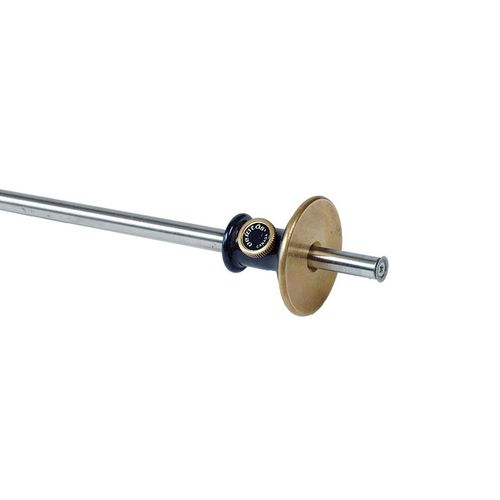
Chopping and paring. To hand-cut a dado, Swann scribes the edges with a marking knife and then chisels shallow V-cuts up to those lines to guide her handsaw.
These are high quality chisels suitable for those prefering tradition and style in woodworking. The blades are made from fine-grained, nicely tempered Cr-Mn steel and hardened to Rc 59. Blade sizes are: 6mm, 12mm, 20mm & 26mm.
Price: $57.82 at the time of writing
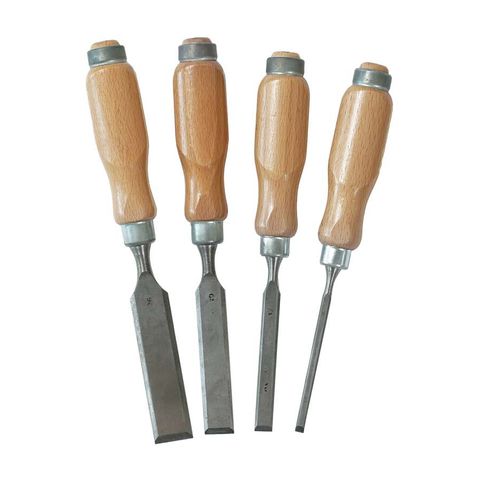
Drive your chisels. Hit your chisel with a mallet for chopping cuts. Here, Swann cleans out the center of the hand-cut dado started earlier.
Wood Is Good WD205 Mallet, 18-oz.
This Wood Is Good 18-Ounce Mallet is guaranteed unbreakable. The head is made of a tough urethane material designed to be quiet and yet able to transmit the maximum blow to the tool. The handle is beautifully turned out of selected New England hardwood and is polish sanded. Urethane head is 2-3/4-inch diameter.
Price: $53.99 at the time of writing
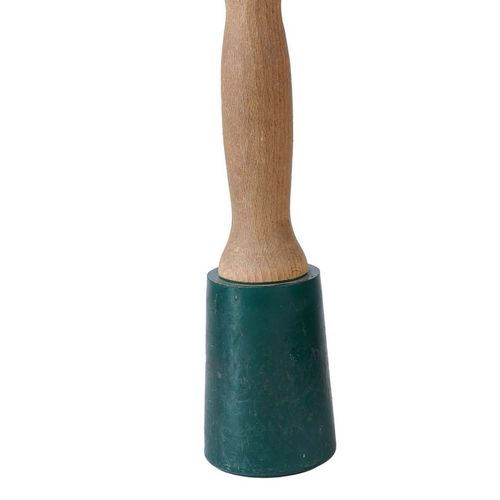
Two handsaws to choose from
Backsaw stays straight. A Western-style backsaw cuts on the push stroke and has a back spine that helps keep its blade straight in a cut.
Veritas Dovetail Saw, Fine-Cut
Made of high-carbon steel, the blade is 9 1/4″ long and 0.020″ thick, with a cut depth of about 1 9/16″. The teeth, set 0.003″ per side, have a rake angle of 14° and an included angle of 60°. The blades have 14 or 20 rip-cut teeth per inch.
Price: $99 at the time of writing
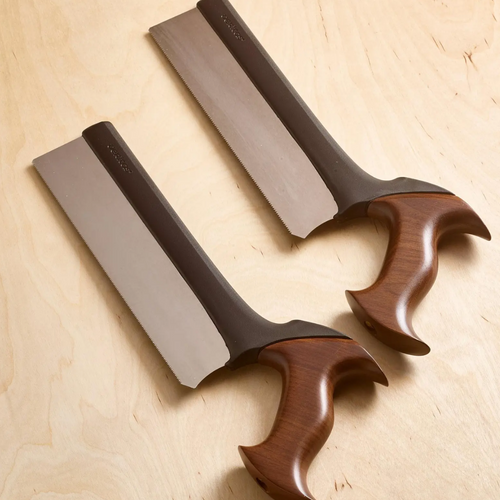
Pullsaw is easier to start. While Western- and Japanese-style saws can handle the same tasks, a Japanese pullsaw makes it easier to start a cut, and it binds less frequently.
Suizan 7-in., Double-Edge, Japanese Pull Saw
SUIZAN is a Japanese brand that produces the highest quality Japanese tools. We manufacture and sell high quality saws with traditional craftsmanship and modern equipment.
Price: $33.80 at the time of writing
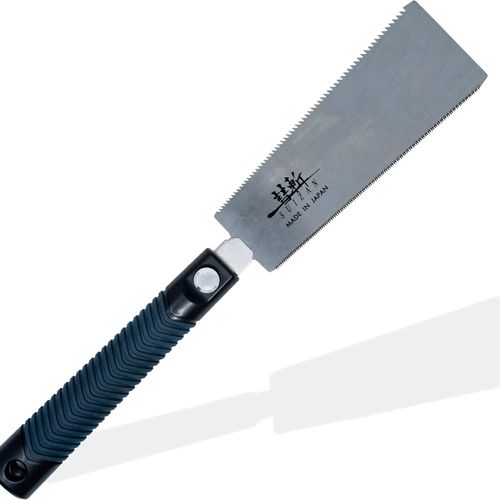
Add these when you’re ready
Add the following tools as you need them, or as your skills and budget allow.
Big jump forward in precision. Digital calipers help you dial in thicknesses, fit tenons, choose the right pilot-hole drill bits, and much more.
6 in. Digital Caliper
Digital Caliper, Caliper Measuring Tool with Stainless Steel, Electronic Micrometer Caliper with Large LCD Screen, Auto-Off Feature, Inch and Millimeter Conversion (6 Inch/150 mm)
Price: $25.99 at the time of writing
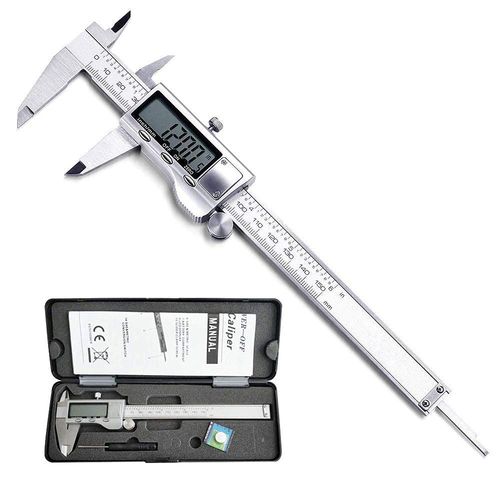
Refine your work. More precise than a sanding block, a block plane cuts clean chamfers, brings one surface level with another, removes machine marks from smaller surfaces, and much more.
Editor recommended block plane
Lie-Nielsen No. 102 Low Angle Block Plane
With smooth, precise adjustments and wonderful balance, this compact block plane is a joy to use. It doesn’t have any bells and whistles, but there’s not a better block plane available for the money.
Price: $160 at the time of writing
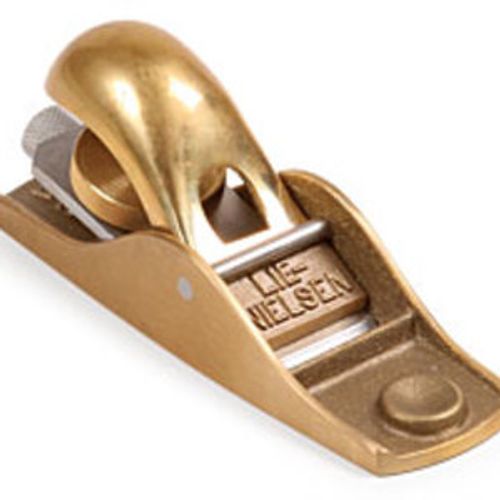
Leave surfaces smooth and flat. A full-size bench plane removes machine marks from larger surfaces such as legs and panels, leaving them perfectly flat in the process.
Veritas Low-Angle Smooth Plane
The cast-iron body is 10″ × 2 1/2″. Weighs just over 3 1/2 lb. Includes a lapped 25° bevel blade, 2″ × 1/8″ thick, in your choice of A2, O1 or PM-V11 tool steel. For working difficult grain, lapped 38° and 50° blades and a toothed A2 blade are available separately.
Price: $285.00 at the time of writing
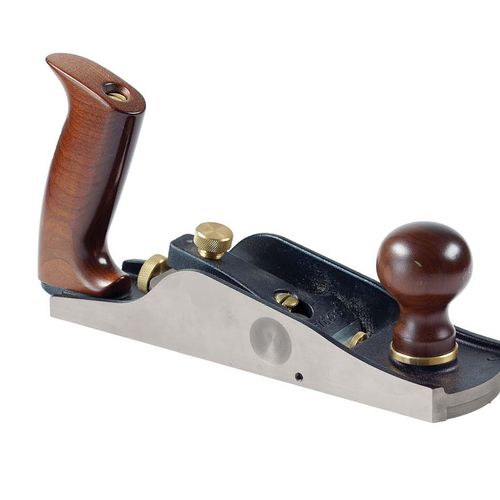
Smooth and save. A card scraper can smooth any surface, regardless of grain direction, and will save you a lot on sandpaper.
Editor Recommended Scraper
Bahco 6-Inch Card Scraper
The size and thickness are what matter here. A consistent performer, this Bahco scraper is found in many shops we visit.
Price: $9.44 at the time of writing

Smooth curves. A flat spokeshave smooths out shallow curves, both concave and convex.
Veritas Flat Spokeshave
The spokeshave has a 2 1/8″ wide PM-V11 tool steel blade, is 10 1/2″ long overall, and weighs about 12 oz.
Price: $165 at the time of writing
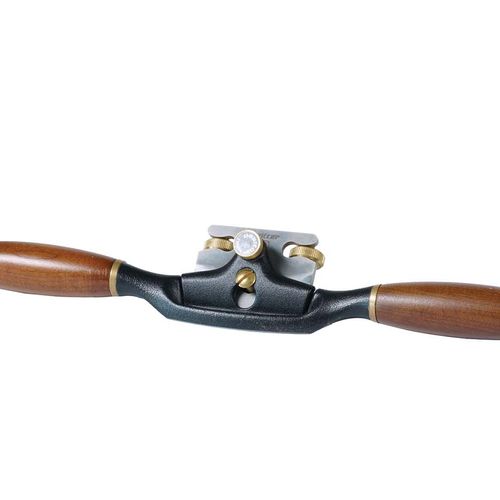
Waste removal. A coping saw is great at removing waste between joinery cuts.
Olson Coping Saw
This is a sturdy, professional saw that allows standard pin end coping saw blades to be tensioned at both ends. Blades can be turned 360 to saw in any direction- push or pull stroke.
Price: $8.49 at the time of writing
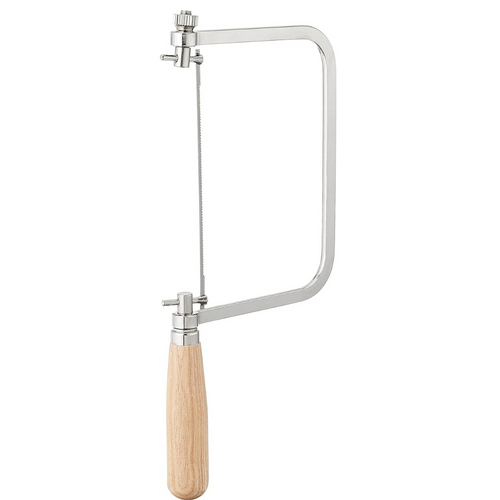
Bottom feeder. A router plane can level and/or deepen the bottom of a cavity, such as a dado, groove, or inlay pocket.
Veritas Large Router Plane
The plane includes two high-carbon steel cutters: a two-piece 1/2″ straight blade, and a two-piece 1/2″ spear-point blade. A blade sharpening jig is also included.
Price: $225 at the time of writing
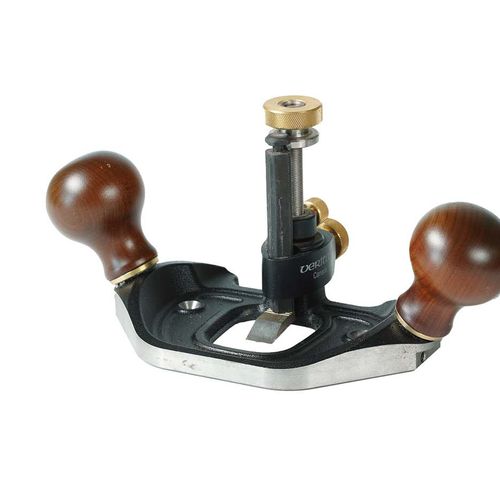
Three more to consider
You might not use these as often as the others, but they are unmatched at what they do.
Transfer any angle. A bevel gauge can transfer an angle from a drawing to a workpiece, or from one workpiece to another. You can also use it to set up machine cuts.
Sliding bevel gauge – Shinwa Sokutei 62588
otal Length: 7.1 inches (180 mm); Nominal Dimensions: 5.9 inches (150 mm); Width: 0.5 inches (14 mm); Thickness: 0.2 inches (5.5 mm); Length: 7.1 inches (180 mm); Width: 0.5 inches (14 mm); Thickness: 0.2 inches (5.5mm)
Price: $14.00 at the time of writing
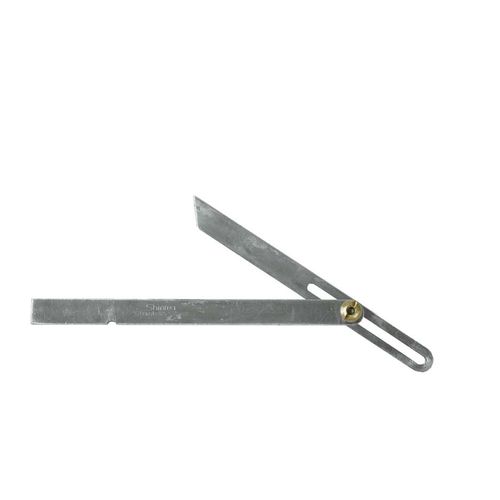
Carry lines around corners. A saddle square lets you wrap layout lines accurately around corners, which is harder to do with a combination square.
Veritas Regular Saddle Square
We have two sizes available, both made of anodized aluminum with end faces machined square to within 1/4°. The original patented square is 2″ wide with 1 1/4″ and 2 1/4″ inside legs; it can be used to wrap a line around workpieces up to almost double this.
Price: $18.50 at the time of writing
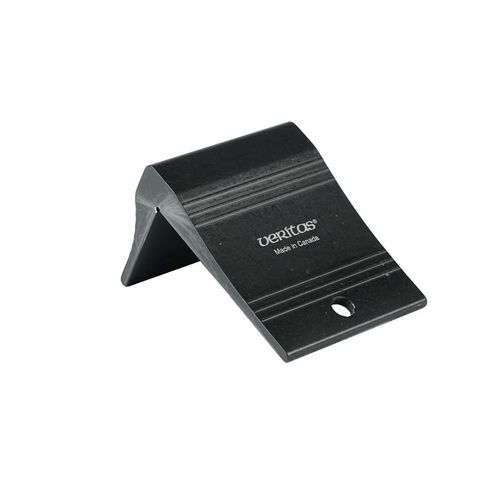
Does one job well. Buy the marker that matches your favorite dovetail angle. It will mark the angled lines and carry the square ones onto the adjacent face.
Veritas Dovetail Saddle Marker
Our dovetail saddle markers are precision machined at 1:6 and 1:8 angles, the traditional angles for softwood and hardwood dovetails respectively.
Price: $17.90 at the time of writing
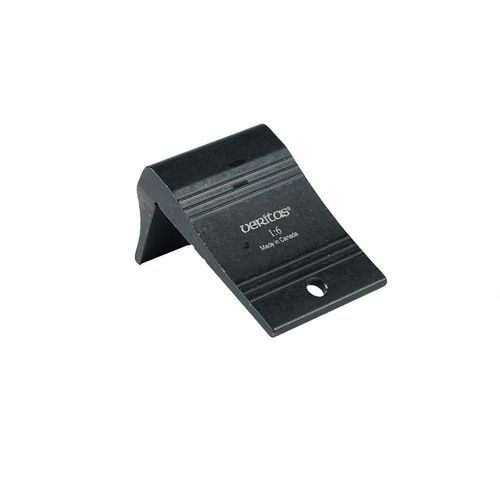
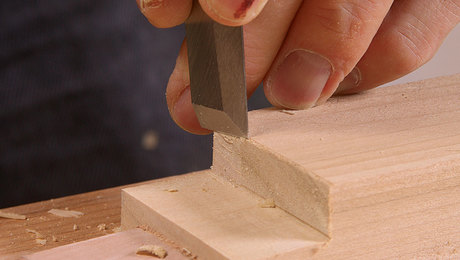
Skill Building Hand-Tool Exercises
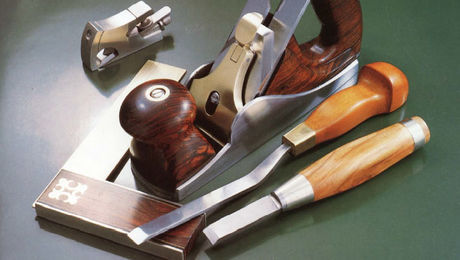
Hand Tools for the Making
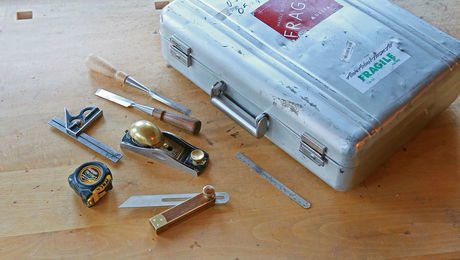
The Only Hand Tools Garrett Hack Really Needs
Sign up for eletters today and get the latest techniques and how-to from Fine Woodworking, plus special offers.
Download FREE PDF
when you enter your email address below.
View PDF


